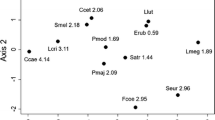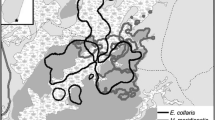Abstract
Reports on behavioural innovations in wild primate populations as well as on their transmission are rare. Here, we report observations suggesting that redfronted lemurs (Eulemur rufifrons) invent new behaviours in the wild. We observed a novel feeding behaviour in redfronted lemurs in Kirindy Forest, western Madagascar. The feeding behaviour consisted of depletion of nests of a social spider species (Stegodyphus sp.). The behaviour was observed in only one out of four study groups, although spider nests were present in the home ranges of all four groups. The behaviour was exhibited in three different years (2009, 2011, 2012) and appears to be re-invented from time to time. Interestingly, in 2011 this behaviour was shown by four individuals and probably spread within the group. This feeding behaviour has only been observed between the middle of June and early August (i.e. the early dry season), and nests were found to be empty later on, suggesting that these nests are available as a food source only seasonally. Our observation contributes a rare case of behavioural innovations in a wild primate population.



Similar content being viewed by others
References
Altmann J (1974) Observational study of behavior: sampling methods. Behaviour 49:227–267
Bodasing M, Crouch T, Slotow R (2002) The influence of starvation on dispersal on the social spider, Stegodyphus mimosarum (Araneae, Eresidae). J Arachnol 30:373–382
Bonnie KE, de Waal FBM (2006) Affiliation promotes the transmission of a social custom: handclap grooming among captive chimpanzees. Primates 47:27–34. doi:10.1007/s10329-005-0141-0
Boogert NJ, Reader S, Hoppitt W, Laland KN (2008) The origin and spread of innovations in starlings. Anim Behav 75:1509–1518. doi:10.1016/j.anbehav.2007.09.033
Borgatti SP, Everett MG, Freeman LC (2002) Ucinet for windows: software for social network analysis. Analytic Technologies, Harvard
Cadieu N, Fruchard S, Cadieu JC (2010) Innovative individuals are not always the best demonstrators: feeding innovation and social transmission in Serinus canaris. Plos One 51:e8841. doi:10.1371/journal.pone.0008841
Coussi-Korbel S, Fragaszy DM (1995) On the relationship between social dynamics and social learning. Anim Behav 50:1441–1453
Donati G, Kesch K, Ndremifidy K, Schmidt SL, Ramanamanjato JB, Borgognini-Tarli SM, Ganzhorn JU (2011) Better few than hungry: flexible feeding ecology of collared lemur (Eulemur collaris) in littoral forest fragments. Plos One 6:e19807. doi:10.1371/journal.pone.0019807
Fichtel C, Kappeler PM (2011) Variation in the meaning of alarm calls in Verreaux’s and Coquerel’s sifakas (Propithecus verreauxi, P. coquereli). Int J Primatol 32:346–361. doi:10.1007/s10764-010-9472-9
Fichtel C, van Schaik C (2006) Semantic differences in sifaka (Propithecus verreauxi) alarm calls: a reflection of genetic or cultural variants? Ethology 112:839–849. doi:10.1111/j.1439-0310.2006.01239.x
Galef BG Jr (2004) Approaches to the study of traditional behaviors of free-living animals. Learn Behav 32:53–61
Hosey GR, Jaques M, Pitts A (1997) Drinking from tails: social learning of a novel behaviour in a group of ring-tailed lemurs (Lemur catta). Primates 38:415–422. doi:10.1007/BF02381881
Huffman MA, Quiatt D (1986) Stone handling by Japanese macaques (Macaca fuscata): implications for tool use of stone. Primates 27:413–423. doi:10.1007/BF02381887
Kappeler PM (1987) The acquisition process of a novel behaviour pattern in a group of ring-tailed lemurs (Lemur catta). Primates 28:225–228
Kappeler PM, Fichtel C (2012a) Female reproductive competition in Eulemur rufifrons: eviction and reproductive restraint in a plurally breeding Malagasy primate. Mol Ecol 21:685–698. doi:10.1111/j.1365-294X.2011.05255.x
Kappeler PM, Fichtel C (2012b) A 15-years perspective on the social organization and life history of sifaka in Kirindy Forest. In: Kappeler PM, Watts DP (eds) Long-term field studies of primates. Springer, Berlin Heidelberg, pp 101–124
Kawai M (1965) Newly-acquired pre-cultural behavior if the natural troop of Japanese macaques on Koshima islet. Primates 6:1–30. doi:10.1007/BF01794457
Laland KN, Janik VM (2006) The animal culture debate. Trends Ecol Evol 21:542–547. doi:10.1016/j.tree.2006.06.005
McGrew WC (1998) Culture in primates? Annu Rev Anthropol 27:301–328
Nishida T, Matsusaka T, McGrew WC (2009) Emergence, propagation or disappearance of novel behavioural patterns in the habituated chimpanzees of Mahale: a review. Primates 50:23–36. doi:10.1007/s10329-008-0109-y
Ostner J, Kappeler PM (2004) Male life history and the unusual adult sex ratios of redfronted lemur, Eulemur fulvus rufus, groups. Anim Behav 67:249–259. doi:10.1016/j.anbehav.2003.05.012
Overdorff DJ (1993) Similarities, differences and seasonal patterns in the diets of Eulemur rubriventer and Eulemur fulvus rufus in the Ranomafana National Park, Madagascar. Int J Primatol 14:721–753
Pareira ME, Kappeler PM (1997) Divergent systems of agonistic behaviour in lemurid primates. Behaviour 134:225–274. doi:10.1163/156853997X00467
Perry S, Panger M, Rose L, Barker M, Gros-Louis J, Jack K, MacKinnon KC, Manson JH, Fedigan LM, Pyle K (2003) Traditions in wild white-faced capuchin monkeys. In: Fragaszy D, Perry S (eds) The biology of traditions: models and evidences. Cambridge University Press, Cambridge, pp 391–425
Ramsey G, Bastian ML, van Schaik C (2007) Animal innovation defined and opterationalized. Behav Brain Sci 30:393–437. doi:10.1017/S0140525X07002373
Reader SM, Laland KN (2001) Primate Innovation: sex, age and social rank differences. Int J Primatol 22:787–805
Reader SM, Laland KN (2003) Animal innovation: an introduction. In: Reader SM, Laland KN (eds) Animal innovation. Oxford University Press, Oxford, pp 83–116
Schnoell AV, Fichtel C (2012) Wild redfronted lemurs (Eulemur rufifrons) use social information to learn new foraging techniques. Anim Cog 15:505–516. doi:10.1007/s10071-012-0477-y
Tarnaud L (2004) Ontogeny of feeding behaviour of Eulemur fulvus in the fry forest of Mayotte. Int J Primatol 25:803–824
Van Schaick CP, Ancrenaz M, Borgan G, Galdikas B, Knott CD, Singleton I, Suzuki A, Utami SS, Merrill M (2003) Orangutan cultures and the evolution of material culture. Science 299:102–105. doi:10.1126/science.1078004
Whiten A, Goodall J, McGrew WC, Nishidas T, Reynolds V, Sugiyama Y, Tutin CEG, Wrangham RW, Boesch C (1999) Cultures in chimpanzees. Nature 399:682–685. doi:10.1038/21415
Acknowledgments
We thank the Département de Biologie Animale, Université d’Antananarivo, the CAFF/CORE of the Direction des Eaux et Forêts and the CNFEREF Morondava for the authorisation of this study. We are very grateful to Tianasoa Andrianjanahary, Mamy Solohery Razafindrasamba and Roberta Aralla for sharing their observations with us, and Jason Gilchrist for sharing his knowledge about the social spiders of Kirindy.
Author information
Authors and Affiliations
Corresponding author
About this article
Cite this article
Schnoell, A.V., Fichtel, C. A novel feeding behaviour in wild redfronted lemurs (Eulemur rufifrons): depletion of spider nests. Primates 54, 371–375 (2013). https://doi.org/10.1007/s10329-013-0356-4
Received:
Accepted:
Published:
Issue Date:
DOI: https://doi.org/10.1007/s10329-013-0356-4




